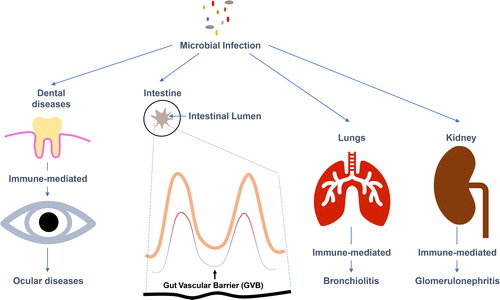Microbial invasion triggers host defense responses to eliminate infection. Bacterial components such as lipopolysaccharides, peptidoglycan, and nucleic acid, and viral components such as viral coat proteins and nucleic acid can activate innate and adaptive immunity and may subsequently perturb the host’s immune homeostasis if immune responses are excessive. Collectively, these immune responses may also trigger destruction of host cells or damage organs, resulting in a wide range of organ pathologies and the development of immunity-mediated diseases. Furthermore, various microbial components show molecular similarity with host molecules and this may cause the phenomenon of molecular mimicry. It is considered that molecular mimicry is responsible for pathogen-induced autoimmune diseases. This issue of International Reviews of Immunology focuses on conventional and specialized microbial entry and the development of localized (or nearby organ) or systemic pathology which may be the outcome of microbial infection, or microbial infection-induced immunopathology ().
Blood filtration is an essential physiological process for a mammal’s survival and it takes place in a specialized organ known as the kidney. Glomerulonephritis is a condition in which the function of the kidney is compromised, resulting in the accumulation of fluid, electrolytes and metabolic waste, which eventually affects vital parameters and other vital organs of the body. Glomerulonephritis can be caused by microbial or parasitic infection. It can also occur as a consequence of an autoimmune disease such as systemic lupus erythematosus or the presence of a tumor. Streptococcus pyogenes is a Group A streptococcus and its infection causes immune-mediated acute post-streptococcal glomerulonephritis (APSGN). The first review article in this issue by Mosquera et al. sheds light on the biology of APSGN. The article also discusses host–streptococcus interaction and the factors involved in glomerulonephritis [Citation1]. The article enriches knowledge by providing a fundamental understanding of bacteria-induced glomerulonephritis and will be of interest to fundamental and clinical immunologists ().
The human body is home to a vast array of microbes that can be found particularly in the skin, gut, urogenital tract and upper respiratory tract. In the gut of a healthy host, these microbes reside in the gut lumen and cannot reach various organs such as the spleen and liver and other vital organs. Recently, a new concept the gut vascular barrier (GVB) has emerged. This concept explains how nonpathogenic gut microbes remain in the lumen, whereas pathogenic microbes breach the GVB and gain access to organs and cause disease. The second review article in this issue by Liu et al. analyzes the genetic profile of the GVB in gut-associated autoimmune disease and cancer in order to gain a better understanding of such diseases and their impact on GVB [Citation2]. This article will be of value to mucosal immunologists and rheumatologists as well as researchers investigating gut-associated cancers ().
Oral health is not only important for chewing and biting of food, but also plays a pivotal role in the pathogenesis of several infectious and noninfectious diseases. Oral/dental diseases such as tooth decay, gum disease, and oral cancer can cause other systemic diseases. These diseases can spread via mouth infection to different organs, or via the dissemination of microbial toxins or their components, or through the development of systemic inflammatory responses. The third review article in this issue by Arjunan et al. discusses the correlation between periodontal disease and an immune-privileged organ, the eye, and the pathogenesis of eye diseases. The article discusses how oral health impacts the development of eye diseases and also how it can accelerate the progression of eye disease that develops due to some other factors such as diabetes. The article also provides mechanistic insights into ocular diseases due to periodontal diseases [Citation3]. This article will be of interest to a broad readership, but will be particularly germane for those wishing to gain a fundamental understanding of this immune-privileged organ and its relation with oral health and the gut system ().
Viral bronchiolitis, a lung infection caused by respiratory syncytial virus, commonly affects infants and young children up to the age of two years. Viral bronchiolitis is an acute condition that initially affects the upper respiratory tract and subsequently progresses to the lower respiratory tract with excessive inflammation and mucus production. Children with viral bronchiolitis present with a runny or stuffy nose, difficulty in breathing, coughing, and occasionally low-grade fever. Additionally, this infection can reach the ear and may cause ear infection. The last article in this issue by Dias et al. analyzes the association of inflammatory cytokine TNF-α and IFN-γ and its link with viral bronchiolitis based on the current literature [Citation4]. This article will be of relevance to a wide readership but especially those in the fields of immunology and viral immunology ().
References
- Acute post-streptococcal glomerulonephritis: Analysis of the pathogenesis. Int Rev Immunol. (1830083).
- The concept revolution of gut barrier: From epithelium to endothelium. Int Rev Immunol. (1841185).
- Eye on the enigmatic link: dysbiotic oral pathogens in ocular diseases: The flip side. Int Rev Immunol. (1845330).
- Association between TNF-α and IFN-γ levels and severity of acute viral bronchiolitis. Int Rev Immunol. (1889534).

